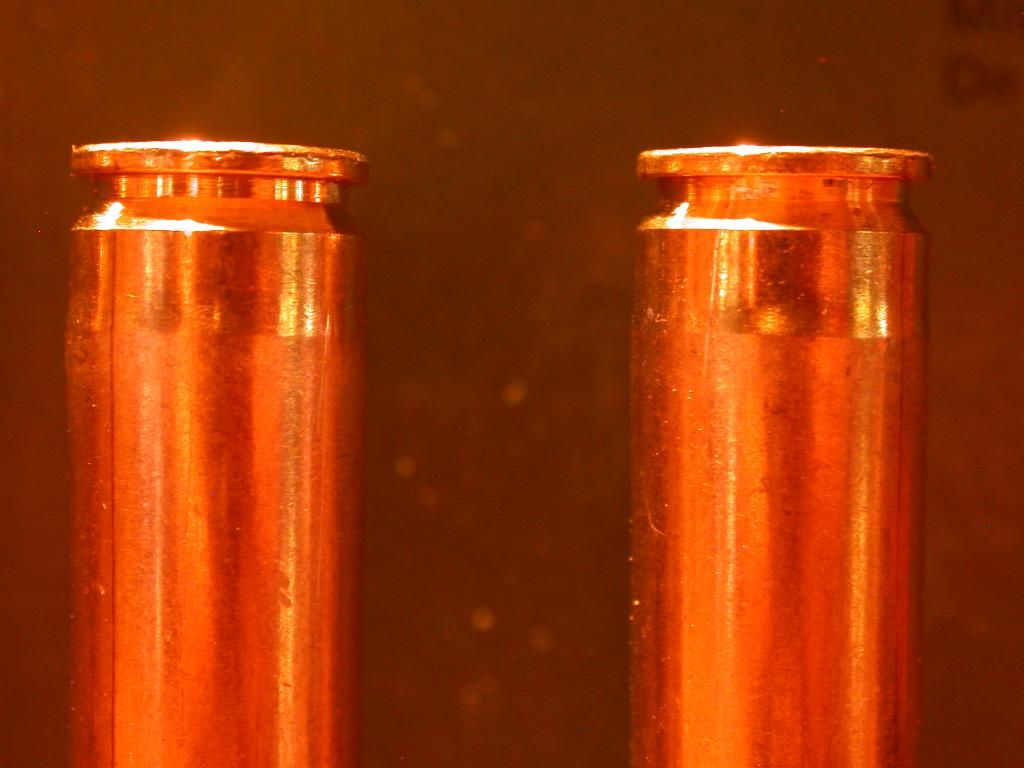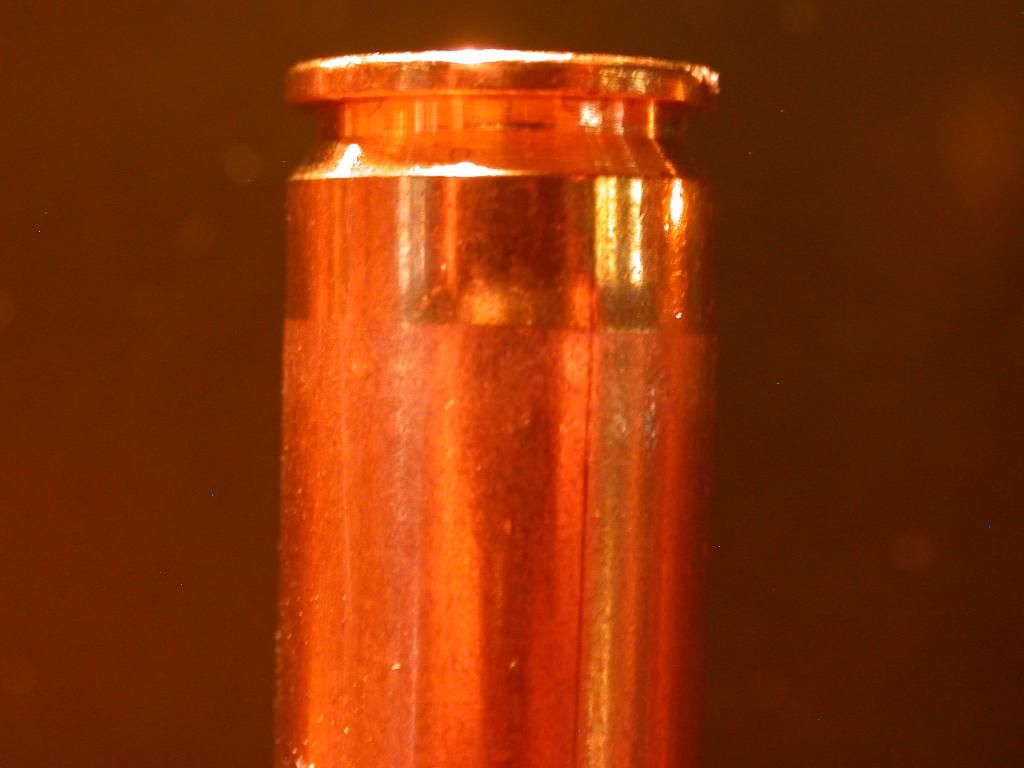

 The Accurate Reloading Forums
The Accurate Reloading Forums  THE ACCURATE RELOADING.COM FORUMS
THE ACCURATE RELOADING.COM FORUMS  Guns, Politics, Gunsmithing & Reloading
Guns, Politics, Gunsmithing & Reloading  Reloading
Reloading  30'06 Chamber dimensions?
30'06 Chamber dimensions?Go  | New  | Find  | Notify  | Tools  | Reply  |  |
| One of Us |
I have a TypeA Mauser in 30'06. I have read that the standard base diameter for the '06 is .470". Four new measurements of factory loaded ammunition show diameters between .463" and 465.6" and various fired cases I have measure around .467". Brass fired from my Mauser measures out right at .470" but looks and feels blown out ahead of the web. All I have fired in it is Remington which does measure out at .463" to start with. Kinda scary looking actually... Is my chamber oversized? My thinking is that this brass is junk once fired in this gun but is it safe to shoot? The action cycles smoothly and I didn't notice anything goofy about the brass until long after the day at the range. | ||
|
| one of us |
Well, you could just neck size after the initial firing . . . just sayin' | |||
|
| One of Us |
SAAMI ammo and chamber dimensions are availablt on the net, Goggle for it. Sounds to me like you fired cases are fine. Fiddling with neck sizing is rarely very helpful with hunting rifles and cartridges. | |||
|
| One of Us |
Hi. Are you saying that he should neck size, or not neck size? Thanks. | |||
|
| one of us |
SAAMI Drawing The base diameter of the cartridge (factory ammo) can not be larger than .4698" But can be smaller by - .008" The chamber is .4708" + .002" | |||
|
| One of Us |
Here is the brass. See how the case is expanded just ahead of the web? Some even expanded asymmetrically so the bulge is more pronounced on one side. This tells me that the cartridge is not sitting square in the chamber. Enough so that the rim isn't even square to the case body anymore! Granted, these were 150 grainers so not much of the bullet would have been in the lead of the bore. My worry is that I could see a case head separation or at the least too much stretching and no case life as far as reloading is concerned.   | |||
|
| One of Us |
Probably about 50% to 75% of the modern factory bolt action rifles on the market will do exactly as you show in the pictures. I currently have both a Rem. 700 and Winchester M-70 that do that very same thing. Eccentric case head and all. And maybe just a little worse. (hard to tell for sure from the photos) Just neck size or use the Lee Collet die, or you can try partial length resizing. The partial length resizing might possibly bulge the case body just a tad more and make the bolt hard to close. Edited: sorry, I missed the part earlier about the case head not being square with the body. None of my rifles are like that or at least noticeable. You might want to take it to a g-smith for a looksy. It might ought to have the barrel set back a bit to help with the over-expanded brass. Won't do anything for the case head being out of square though. Or you could just lighten up your loads a bunch. "The right to bear arms" insures your right to freedom, free speech, religion, your choice of doctors, etc. ....etc. ....etc.... -----------------------------------one trillion seconds = 31,709 years------------------- | |||
|
| One of Us |
The chamber is a little large and the brass appears to be a bit on the thin side. USGI milspec brass is not so bad about doing that since it is thicker in the case walls. Take a look at brass fired in a .303 British Lee-Enfield. It is even worse. | |||
|
| One of Us |
My 03A3 does the same thing and still shoots 5/8" groups with neck-sized brass. My loads are nearly 95% of max loads and I rarely cut metal when I run them through the trimmer - which I do each reloading just as part of the routine. The only time I had near a case head separation was back when I was full length sizing - 30 years ago. Speer, Sierra, Lyman, Hornady, Hodgdon have reliable reloading data. You won't find it on so and so's web page. | |||
|
one of us |
You`r seeing the point on the case the die stops sizing. All chambers have to be a hair larger then the cartridge to allow it to enter smoothly. Pressure expands the brass on firing and the case usually grows to fit the chamber except at the solid web. When you resize the case walls are squeezed back down but the web area being its normal size isn`t. The ovate shape brass takes is due to uneven wall thickness. The wall expands more where it is thinnest. ------------------------------------ The trouble with the Internet is that it's replacing masturbation as a leisure activity. ~Patrick Murray "Why shouldn`t truth be stranger then fiction? Fiction after all has to make sense." (Samual Clemens) "Saepe errans, numquam dubitans --Frequently in error, never in doubt". | |||
|
| One of Us |
Yes. Or, no. No one can intelligently tell anyone else what neck sizing will do for their loads and rigs. I can say necksizing rarely does anything useful and, when it does, the difference isn't much if everything else is properly done. If a necksized load isn't well done, the end results will be worse. By design, the smallest chambers are larger in every dimension than the largest cartridge. The bulged case photos above show normal expansion ahead of the thick part of the cases; it's often called the "pressure ring" but the whole case is exposed to the same pressure so it would be better to say it's the expansion ring or bulge. Each case's fired bulge is symmetrical or asymmetrical due to thin or soft case walls, it's no more complicated than that. A sizing die quits working there because nothing below that point has expanded. The bulge is quite small and, of itself, has no particular effect on safety, head seperations or case life. | |||
|
| One of Us |
In most cases (no pun intended) the uneven bulge has nothing to do with case walls being thin or soft. Rather it has to do with the extractor pushing the case to one side (or the bottom with a M94 Win) of the chamber and holding it there when the round is fired. You can test this by clocking the headstamp and closing the bolt and firing the rounds. The bulge will always appear on the side contacted by the extractor. | |||
|
| One of Us |
I have only been neck-sizing my brass for the last twenty or more years and My brass shows the same pattern as the pictures. Some have been loaded over twenty times and I don't have any problems with cases failing at all. They all feed easily into my chamber, there is no perceptable lengthening to the shoulder and I get sub MOA accuracy from an old 03A3 3006. I actually only size part of the neck leaving the last bit to keep the bullet centered more closely with the bore. My experience has shown me that as long as I am not "hotrodding" the loads the brass will last a very long time because it is not being worked by resizing and expansion with each firing. I am the first to admit that the military chamber is on the "large" size and that the lead is too long to seat any bullet close to the rifling but with the proper load work-up I have been able to produce sub-MOA groups with bullets from 110 grains to 200 grains in my rifle. Speer, Sierra, Lyman, Hornady, Hodgdon have reliable reloading data. You won't find it on so and so's web page. | |||
|
| Powered by Social Strata |
| Please Wait. Your request is being processed... |
|

Visit our on-line store for AR Memorabilia

